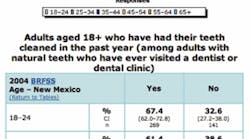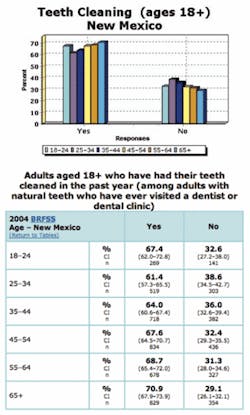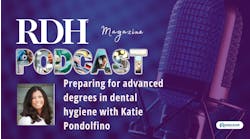Do You Need Information About Dental Health in Your State?
by Christine Nathe, RDH, MS
If you need information about dental health in your state, please visit the National Oral Health Surveillance System Web site!
So often, dental hygienists are asked about dental health within their communities. In fact, when dental hygienists collaborate with others to develop innovative dental health programs, the first step is finding out if there is a dental disease problem within their communities. Or maybe an issue with accessing dental care. Collecting data can help verify a problem or issue and is necessary when promoting the significant need for dental care.
Well, the government has made it a little easier to get information about your state, and you can even get information about neighboring states or compare your state information to the national data. It"s called the National Oral Health Surveillance System. The NOHSS is a collaborative effort between CDC"s Division of Oral Health and the Association of State and Territorial Dental Directors (ASTDD). NOHSS is designed to monitor the burden of oral disease, use of the oral health-care delivery system, and the status of community water fluoridation on both a national and state level.
The Council of State and Territorial Epidemiologists (CSTE) and the National Association of Chronic Disease Directors (NACDD) were instrumental in developing the framework for chronic disease surveillance indicators and these oral health indicators. Three of the oral health indicators — dental visit, dental cleaning, and complete tooth loss — are among the chronic disease indicators.
Oral Health Indicators
- Dental visit. Adults aged 18+ who have visited a dentist or dental clinic in the past year. Routine dental visits aid in the prevention, early detection, and treatment of tooth decay, oral soft tissue disease, and periodontal diseases.
- Teeth cleaning. Adults aged 18+ who have had their teeth cleaned in the past year (among adults with natural teeth who have ever visited a dentist or dental clinic). Having one"s teeth cleaned by a dentist or dental hygienist is an indicator of preventive behavior.
- Complete tooth loss. Adults aged 65+ who have lost all of their natural teeth due to tooth decay or gum disease. Loss of all natural permanent teeth (complete tooth loss) may substantially impair a person"s quality of life, self-image, and daily functioning.
- Lost six or more teeth. Adults aged 65+ who have lost six or more teeth due to tooth decay or gum disease. Tooth loss can have an impact on food choices, quality of life, and self-image.
- Fluoridation status. Percentage of people served by public water systems who receive fluoridated water. Water fluoridation plays an important role in reducing tooth decay and tooth loss.
- Dental sealants. Percentage of third grade students with dental sealants on at least one permanent molar tooth. Plastic coatings applied to decay-susceptible tooth surfaces (the pits and fissures) can reduce tooth decay — the Task Force on Community Preventive Services strongly recommended school-based or school-linked dental sealant programs in its 2001 report. These materials have been approved for use for many years, and are recommended by professional health associations and public health agencies, particularly for children at high risk for tooth decay.
- Caries experience. Percentage of third grade students with caries experience, including treated and untreated tooth decay. Dental caries (tooth decay) is the single most common chronic childhood disease.
- Untreated tooth decay. Percentage of third grade students with untreated tooth decay. To avoid pain and discomfort, decayed teeth need to be restored (filled). To keep as much of the natural tooth as possible, tooth decay should be discovered early and treated promptly so that fillings may be kept small.
- Cancer of the oral cavity and pharynx. Oral and pharyngeal cancer comprises a diverse group of malignant tumors that affect the oral cavity and pharynx (mouth and throat). Each year, some 28,000 new cases of oral and pharyngeal cancer are diagnosed and 7,200 people die from the disease. The most recent statistics for oral and pharyngeal cancer are available at the U.S. Cancer Statistics Web site http://www.cdc.gov/cancer/npcr/uscs/index.htm. For more information on oral cancer, see Oral Health Resources: Oral Cancer and Cancer Prevention and Control: National Cancer Data at http://www.cdc.gov/OralHealth/topics/cancer.htm.
Here is a sample of data from my state, New Mexico, on the percentage of New Mexicans who had received a dental cleaning within the past year, based on their ages. But the charts can be developed for a variety of demographic data.
Please make sure to use this information when needed. It sure can make your job as a fact finder easier and hopefully help you in collecting baseline data when developing new preventive programs!
Please see http://www.cdc.gov/nohss/ for more information where most of this information was gathered!







